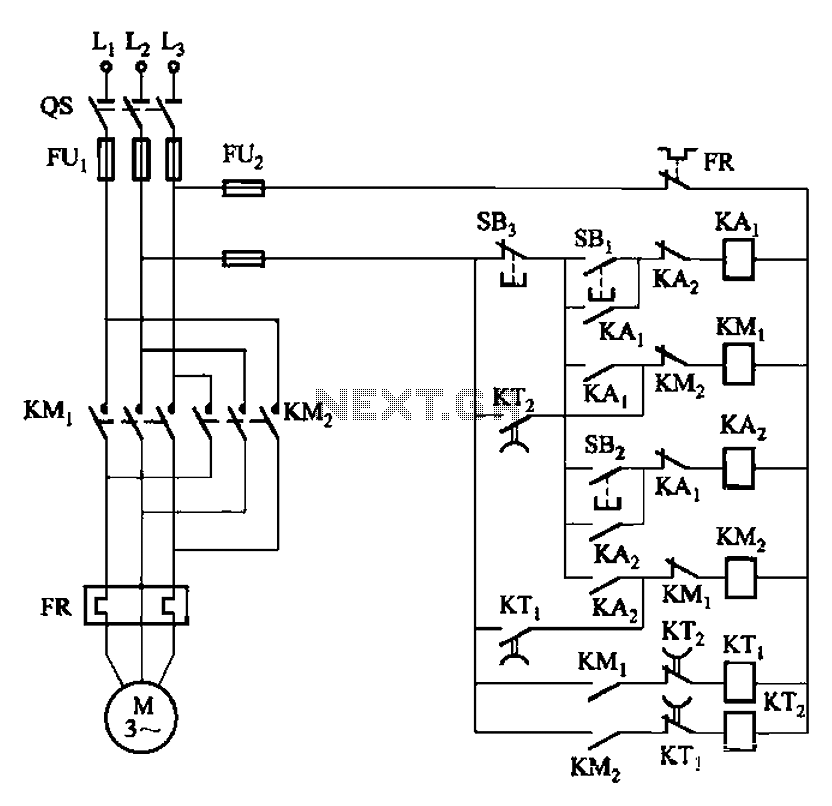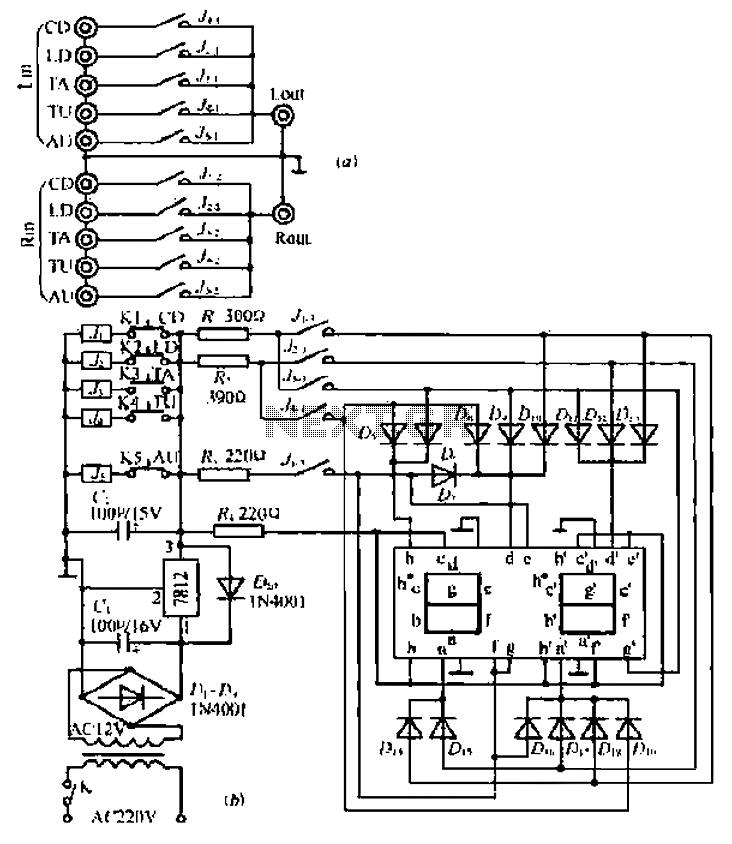
rtc circuit

A miniature real-time controller manages night lights, air conditioning units, and household appliances with a programmable scheduler. The device utilizes modified source code and a hex file for year 2002 readout. The circuit comprises three primary chips: an 89C2051 microcontroller, a DS275 (or MAX232) for RS232 communication, and a 74LS07 open collector driver. The scheduler allows for time-based control of six output channels, which can be programmed and saved in on-chip RAM via a PC. Each output channel can sink 20 mA, making it suitable for driving a homemade opto-triac or a large solid-state relay for heavier loads. The 89C2051 operates at a low-cost frequency of 3.579 MHz, executing the timer6.hex program. The output channels are mapped to P1.2 to P1.7, with the 74LS07 providing approximately 20 mA at 12V for opto-triac operation. Two 1N914 signal diodes serve as a backup power supply for the 89C2051. The reset functionality relies on a simple RC circuit, lacking brownout protection and a reset switch, which can lead to operational issues when powered by a battery for extended periods. The RS232 level converter can be substituted with any compatible converter, such as the MAX232 or a basic transistor circuit. An opto-triac with zero-crossing capability can be constructed easily, with the MOC3041 used to drive a 5A 240V triac. The night light primarily consists of an incandescent lamp, and the circuit performs reliably. For heavier loads like air conditioning, a solid-state relay such as the CRYDOM D2410 is utilized. The scheduler program can be downloaded as a text file via communication software like Xtalk, ensuring that the character transmission matches the controller's receiving speed. Adjustments to the year readout have been made, specifically for Thailand's Buddhist Era, by modifying byte 25 to 20, with plans for future adjustments as needed. A new version of the miniature real-time controller has been developed using C source code and employs an 8051SBC as a terminal for time setting. The scheduler is fixed, but modifications can be made by editing the PGM[] array and recompiling the source code. The connection between the RTC and 8051SBC is established using an RS232 cross cable, with two onboard buttons for hour and minute adjustments. The main program is driven by timer0 interrupts, set to a 16-bit timer mode with a 1/10 second interrupt rate. The time function updates the clock every 0.1 seconds, printing the current time every second and scanning the preset scheduler every minute. Hour and minute adjustments are made by waiting for characters sent from the terminal, with commands 'h' and 'm' used for hour and minute adjustments, respectively. A push button connected to P3.2 manually activates P1.7, allowing for manual control of devices, such as air conditioning, ahead of the scheduled activation at 22:00. The PGM[] array consists of 7x3 bytes, with the first two bytes indicating HOUR:MIN and the third byte determining the output port P1 status, where logic one represents an ON condition. The output is buffered with a 7407 open collector gate, which complements the bits before writing them to the output port.
The miniature real-time controller circuit is designed to efficiently manage multiple household appliances through a compact and programmable system. The core component, the 89C2051 microcontroller, serves as the brain of the operation, executing the timer6.hex program to maintain time and control the outputs. The use of a low-cost crystal oscillator ensures that the device remains affordable while providing accurate timing functionality.
The six-channel output capability allows users to control various appliances independently, with the ability to program schedules directly from a PC. This feature enhances user convenience, enabling automated operation of devices such as lights and air conditioning units based on user-defined time intervals. The 20 mA sinking current capability of each output channel is sufficient for driving opto-triacs and solid-state relays, which are essential for managing higher power loads safely and efficiently.
The design incorporates a robust backup power system using 1N914 diodes, ensuring that the microcontroller remains operational even in the event of power fluctuations. The absence of brownout protection highlights an area for potential improvement, particularly for applications where battery power is a primary source. The ability to reset the device by removing and reinserting the battery provides a simple workaround for operational issues.
The RS232 communication interface allows for easy programming and interaction with the device, with flexibility to use various level converters. The option to customize the year readout for specific regional requirements, such as the Buddhist Era in Thailand, demonstrates the adaptability of the system to meet local needs.
Overall, the miniature real-time controller circuit exemplifies a well-thought-out design that balances functionality, cost, and user-friendly features, making it an effective solution for home automation applications. The integration of a programmable scheduler, manual control options, and the ability to handle multiple devices positions this controller as a valuable tool for modern household management.A Miniature Real-time Controller controls night light, A/C, household appliances with programmable scheduler. Modified source code and hex file for year 2002 readout. This is my long history the device that controls my home`s night light, air-conditioner, etc. The device is a Miniature Real-time Controller. The circuit uses only three chips, a 89C2051, DS275(or MAX232), and 74LS07 open collector driver. The scheduler for time on/off of 6-channel output can be made by downloading from PC and saved into onchip RAM. Each output provides a 20mA sinking suitable for driving a homemade opto-triac or big solid-state relay for heavy load.
A circuit diagram of the Miniature Real-time Controller is shown in Figure 1. A 89C2051 with a low-cost X-tal 3. 579MHz runs timer6. hex. The 6-channel output is P1. 2 to P1. 7 driving with sink current. A 74LS07 open collector provides approx. max 20mA @12V suitable for driving a homemade opto-triac shown in Figure 2. Two signal diodes, 1N914, provide simple backing up supply for the 89C2051. Since RST uses simple RC circuit, there is no brownout protection and reset switch thus when the controller operated with battery for long time, the chip may knock. Simply take the battery out and put them again. The RS232 level converter, instead of DS275, any converter may use, say MAX232, or simple circuit using two transistors.
An opto-triac with zero-crossing can be made easily. I have used an MOC3041 to drive 5A 240V triac. A night light used in my home mostly be an incandescent lamp, the circuit below works fine. For such heavy load as air-conditioner, I used a solid-state relay, one from CRYDOM D2410, say. Example of scheduler air. pgm was written as a text file. Downloading to the controller may simply do via communication program, Xtalk or any others program but sending each character should matched the receiving speed of the controller. For Xtalk, the speed may reduced by changing CWAIT command( there`s no XON/XOFF flow control). I got a mail asking for changing year readout. The readout shown in Figure 4 is for Thailand, we use Buddhist Era. So I modified the byte 25 to 20. This byte is fixed to 20, next 100 years you have to change it again to 21, say. But I thought may be no need anymore. The new version of miniature real-time controller is developed with c source code and use 8051SBC as a terminal for time setting.
Time scheduler is fixed. To modify it, edit the array, PGM[] and recompile the source code. Figure 5 shows the connection using RS232 cross cable between RTC and 8051SBC. The onboard two buttons are used for HOUR and MIN adjusting. Main program is timer0 interrupt driven. The timer0 is set to 16-bit timer mode with 1/10s interrupt rate. Every 0. 1s the time functions is entered updating the clock. In time function, the program prints current time every one second and scans the preset scheduler every one minute. Adjusting current hour and minute are done by waiting the character sent from terminal. Command `h` will adjust current hour and `m` for current minute. P3. 2 has push button key, when pressed it will make P1. 7 to logic 0. This key is for manual turn on for some device. I used it for manual turn on the air conditioning, since the scheduler will turn it on at 22:00. Sometime I need it to turn on earlier. The array pgm[] contains 7x3 bytes. The first two bytes for each one are set HOUR:MIN. The third byte is byte to be sent to the output port P1. Logic one for each bit represents ON condition. The output is buffered with open collector gate, 7407, so the bit is then complemented before written.
🔗 External reference
The miniature real-time controller circuit is designed to efficiently manage multiple household appliances through a compact and programmable system. The core component, the 89C2051 microcontroller, serves as the brain of the operation, executing the timer6.hex program to maintain time and control the outputs. The use of a low-cost crystal oscillator ensures that the device remains affordable while providing accurate timing functionality.
The six-channel output capability allows users to control various appliances independently, with the ability to program schedules directly from a PC. This feature enhances user convenience, enabling automated operation of devices such as lights and air conditioning units based on user-defined time intervals. The 20 mA sinking current capability of each output channel is sufficient for driving opto-triacs and solid-state relays, which are essential for managing higher power loads safely and efficiently.
The design incorporates a robust backup power system using 1N914 diodes, ensuring that the microcontroller remains operational even in the event of power fluctuations. The absence of brownout protection highlights an area for potential improvement, particularly for applications where battery power is a primary source. The ability to reset the device by removing and reinserting the battery provides a simple workaround for operational issues.
The RS232 communication interface allows for easy programming and interaction with the device, with flexibility to use various level converters. The option to customize the year readout for specific regional requirements, such as the Buddhist Era in Thailand, demonstrates the adaptability of the system to meet local needs.
Overall, the miniature real-time controller circuit exemplifies a well-thought-out design that balances functionality, cost, and user-friendly features, making it an effective solution for home automation applications. The integration of a programmable scheduler, manual control options, and the ability to handle multiple devices positions this controller as a valuable tool for modern household management.A Miniature Real-time Controller controls night light, A/C, household appliances with programmable scheduler. Modified source code and hex file for year 2002 readout. This is my long history the device that controls my home`s night light, air-conditioner, etc. The device is a Miniature Real-time Controller. The circuit uses only three chips, a 89C2051, DS275(or MAX232), and 74LS07 open collector driver. The scheduler for time on/off of 6-channel output can be made by downloading from PC and saved into onchip RAM. Each output provides a 20mA sinking suitable for driving a homemade opto-triac or big solid-state relay for heavy load.
A circuit diagram of the Miniature Real-time Controller is shown in Figure 1. A 89C2051 with a low-cost X-tal 3. 579MHz runs timer6. hex. The 6-channel output is P1. 2 to P1. 7 driving with sink current. A 74LS07 open collector provides approx. max 20mA @12V suitable for driving a homemade opto-triac shown in Figure 2. Two signal diodes, 1N914, provide simple backing up supply for the 89C2051. Since RST uses simple RC circuit, there is no brownout protection and reset switch thus when the controller operated with battery for long time, the chip may knock. Simply take the battery out and put them again. The RS232 level converter, instead of DS275, any converter may use, say MAX232, or simple circuit using two transistors.
An opto-triac with zero-crossing can be made easily. I have used an MOC3041 to drive 5A 240V triac. A night light used in my home mostly be an incandescent lamp, the circuit below works fine. For such heavy load as air-conditioner, I used a solid-state relay, one from CRYDOM D2410, say. Example of scheduler air. pgm was written as a text file. Downloading to the controller may simply do via communication program, Xtalk or any others program but sending each character should matched the receiving speed of the controller. For Xtalk, the speed may reduced by changing CWAIT command( there`s no XON/XOFF flow control). I got a mail asking for changing year readout. The readout shown in Figure 4 is for Thailand, we use Buddhist Era. So I modified the byte 25 to 20. This byte is fixed to 20, next 100 years you have to change it again to 21, say. But I thought may be no need anymore. The new version of miniature real-time controller is developed with c source code and use 8051SBC as a terminal for time setting.
Time scheduler is fixed. To modify it, edit the array, PGM[] and recompile the source code. Figure 5 shows the connection using RS232 cross cable between RTC and 8051SBC. The onboard two buttons are used for HOUR and MIN adjusting. Main program is timer0 interrupt driven. The timer0 is set to 16-bit timer mode with 1/10s interrupt rate. Every 0. 1s the time functions is entered updating the clock. In time function, the program prints current time every one second and scans the preset scheduler every one minute. Adjusting current hour and minute are done by waiting the character sent from terminal. Command `h` will adjust current hour and `m` for current minute. P3. 2 has push button key, when pressed it will make P1. 7 to logic 0. This key is for manual turn on for some device. I used it for manual turn on the air conditioning, since the scheduler will turn it on at 22:00. Sometime I need it to turn on earlier. The array pgm[] contains 7x3 bytes. The first two bytes for each one are set HOUR:MIN. The third byte is byte to be sent to the output port P1. Logic one for each bit represents ON condition. The output is buffered with open collector gate, 7407, so the bit is then complemented before written.
🔗 External reference





